IndrajeetPatil / Ggstatsplot
Programming Languages
Projects that are alternatives of or similar to Ggstatsplot
ggstatsplot: ggplot2 Based Plots with Statistical Details
| Package | Status | Usage | GitHub | Miscellaneous |
|---|---|---|---|---|
 |
 |
|||
 |
 |
|||
 |
 |
 |
||
 |
 |
|||
 |
 |
 |
||
 |
 |
Raison d’être 
“What is to be sought in designs for the display of information is the clear portrayal of complexity. Not the complication of the simple; rather … the revelation of the complex.”
- Edward R. Tufte
ggstatsplot is an
extension of ggplot2 package
for creating graphics with details from statistical tests included in
the information-rich plots themselves. In a typical exploratory data
analysis workflow, data visualization and statistical modeling are two
different phases: visualization informs modeling, and modeling in its
turn can suggest a different visualization method, and so on and so
forth. The central idea of ggstatsplot is simple: combine these two
phases into one in the form of graphics with statistical details, which
makes data exploration simpler and faster.
Summary of available plots
It, therefore, produces a limited kinds of plots for the supported analyses:
| Function | Plot | Description |
|---|---|---|
ggbetweenstats |
violin plots | for comparisons between groups/conditions |
ggwithinstats |
violin plots | for comparisons within groups/conditions |
gghistostats |
histograms | for distribution about numeric variable |
ggdotplotstats |
dot plots/charts | for distribution about labeled numeric variable |
ggscatterstats |
scatterplots | for correlation between two variables |
ggcorrmat |
correlation matrices | for correlations between multiple variables |
ggpiestats |
pie charts | for categorical data |
ggbarstats |
bar charts | for categorical data |
ggcoefstats |
dot-and-whisker plots | for regression models and meta-analysis |
In addition to these basic plots, ggstatsplot also provides
grouped_ versions (see below) that makes it easy to repeat the
same analysis for any grouping variable.
Summary of types of statistical analyses
The table below summarizes all the different types of analyses currently supported in this package-
| Functions | Description | Parametric | Non-parametric | Robust | Bayesian |
|---|---|---|---|---|---|
ggbetweenstats |
Between group/condition comparisons | Yes | Yes | Yes | Yes |
ggwithinstats |
Within group/condition comparisons | Yes | Yes | Yes | Yes |
gghistostats, ggdotplotstats
|
Distribution of a numeric variable | Yes | Yes | Yes | Yes |
ggcorrmat |
Correlation matrix | Yes | Yes | Yes | Yes |
ggscatterstats |
Correlation between two variables | Yes | Yes | Yes | Yes |
ggpiestats, ggbarstats
|
Association between categorical variables | Yes | NA |
NA |
Yes |
ggpiestats, ggbarstats
|
Equal proportions for categorical variable levels | Yes | NA |
NA |
Yes |
ggcoefstats |
Regression model coefficients | Yes | Yes | Yes | Yes |
ggcoefstats |
Random-effects meta-analysis | Yes | NA |
Yes | Yes |
Summary of Bayesian analysis
| Analysis | Hypothesis testing | Estimation |
|---|---|---|
| (one/two-sample) t-test | Yes | Yes |
| one-way ANOVA | Yes | Yes |
| correlation | Yes | Yes |
| (one/two-way) contingency table | Yes | Yes |
| random-effects meta-analysis | Yes | Yes |
Statistical reporting
For all statistical tests reported in the plots, the default template abides by the APA gold standard for statistical reporting. For example, here are results from Yuen’s test for trimmed means (robust t-test):
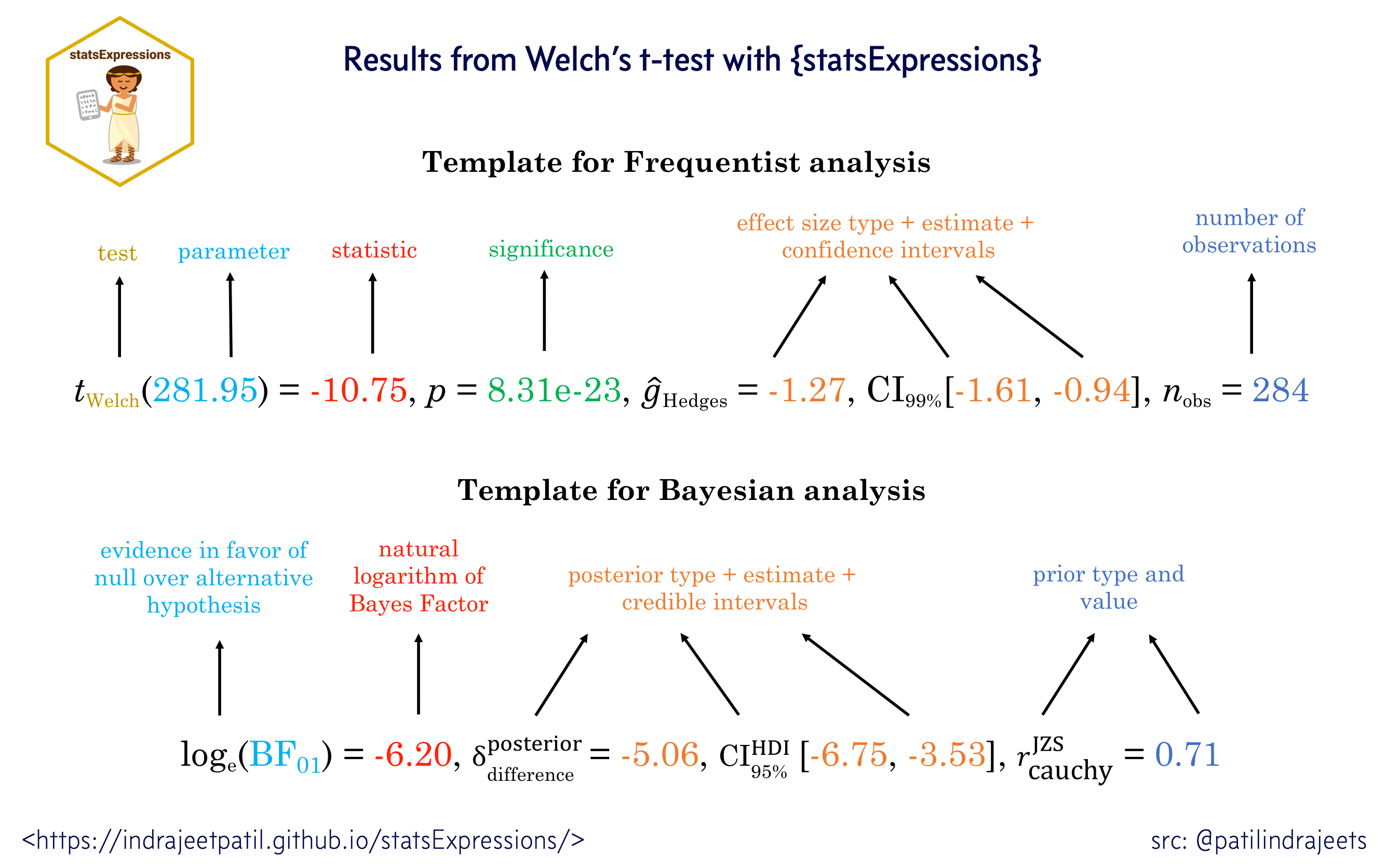
Summary of statistical tests and effect sizes
Here is a summary table of all the statistical tests currently supported across various functions: https://indrajeetpatil.github.io/statsExpressions/articles/stats_details.html
Installation
To get the latest, stable CRAN release:
install.packages("ggstatsplot")
Note:
Linux users may encounter some installation problems, as several R
packages require external libraries on the system, especially for
PMCMRplus package. The following README file briefly describes the
installation procedure:
https://CRAN.R-project.org/package=PMCMRplus/readme/README.html
You can get the development version of the package from GitHub.
If you are in hurry and want to reduce the time of installation, prefer-
# needed package to download from GitHub repo
install.packages("remotes")
# downloading the package from GitHub (needs `remotes` package to be installed)
remotes::install_github(
repo = "IndrajeetPatil/ggstatsplot", # package path on GitHub
dependencies = FALSE, # assumes you have already installed needed packages
quick = TRUE # skips docs, demos, and vignettes
)
If time is not a constraint-
remotes::install_github(
repo = "IndrajeetPatil/ggstatsplot", # package path on GitHub
dependencies = TRUE, # installs packages which ggstatsplot depends on
upgrade_dependencies = TRUE # updates any out of date dependencies
)
To see what new changes (and bug fixes) have been made to the package
since the last release on CRAN, you can check the detailed log of
changes here:
https://indrajeetpatil.github.io/ggstatsplot/news/index.html
Citation
If you want to cite this package in a scientific journal or in any other
context, run the following code in your R console:
citation("ggstatsplot")
Patil, I. (2018). ggstatsplot: 'ggplot2' Based Plots with Statistical
Details. CRAN. Retrieved from
https://cran.r-project.org/web/packages/ggstatsplot/index.html
A BibTeX entry for LaTeX users is
@Article{,
title = {{ggstatsplot}: 'ggplot2' Based Plots with Statistical Details},
author = {Indrajeet Patil},
year = {2018},
journal = {CRAN},
url = {https://CRAN.R-project.org/package=ggstatsplot},
doi = {10.5281/zenodo.2074621},
}
There is currently a publication in preparation corresponding to this package and the citation will be updated once it’s published.
Documentation and Examples
To see the detailed documentation for each function in the stable CRAN version of the package, see:
-
README: https://CRAN.R-project.org/package=ggstatsplot/readme/README.html
-
Presentation: https://indrajeetpatil.github.io/ggstatsplot_slides/slides/ggstatsplot_presentation.html#1
-
Vignettes: https://CRAN.R-project.org/package=ggstatsplot/vignettes/additional.html
To see the documentation relevant for the development version of the
package, see the dedicated website for ggstatplot, which is updated
after every new commit: https://indrajeetpatil.github.io/ggstatsplot/.
Primary functions
Here are examples of the main functions currently supported in
ggstatsplot.
Note: If you are reading this on GitHub repository, the
documentation below is for the development version of the package.
So you may see some features available here that are not currently
present in the stable version of this package on CRAN. For
documentation relevant for the CRAN version, see:
https://CRAN.R-project.org/package=ggstatsplot/readme/README.html
ggbetweenstats
This function creates either a violin plot, a box plot, or a mix of two for between-group or between-condition comparisons with results from statistical tests in the subtitle. The simplest function call looks like this-
# for reproducibility
set.seed(123)
library(ggstatsplot)
# plot
ggbetweenstats(
data = iris,
x = Species,
y = Sepal.Length,
title = "Distribution of sepal length across Iris species"
)
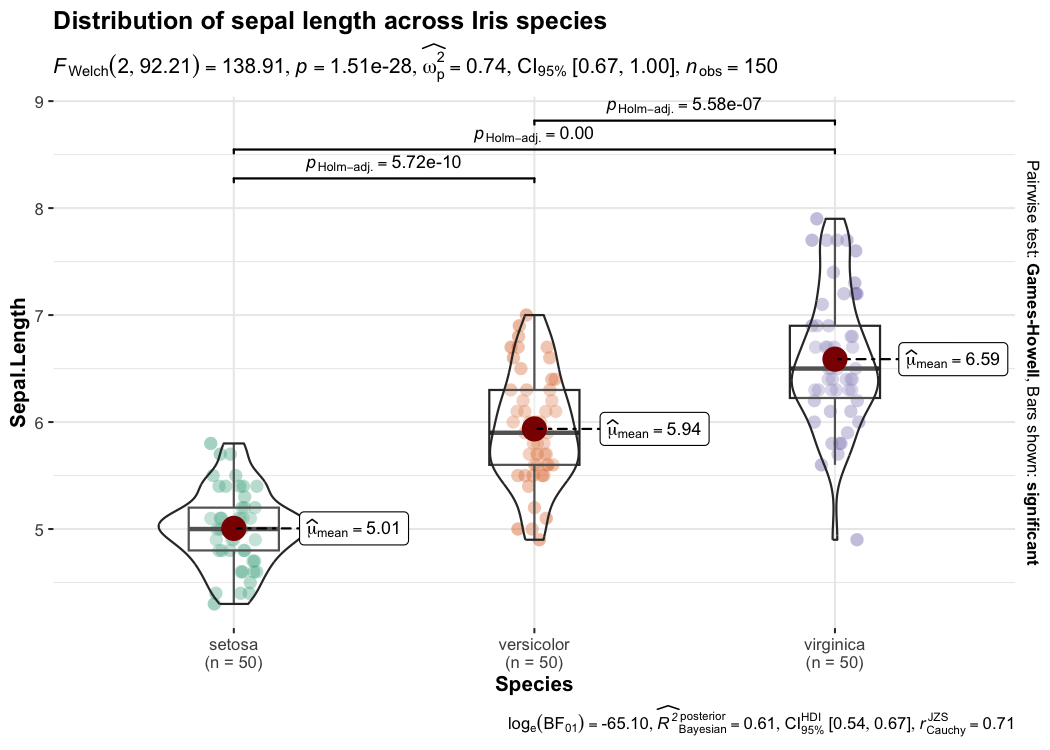
📝 Defaults return
✅ raw data + distributions
✅ descriptive statistics
✅
inferential statistics
✅ effect size + CIs
✅ pairwise
comparisons
✅ Bayesian hypothesis-testing
✅ Bayesian
estimation
A number of other arguments can be specified to make this plot even more informative or change some of the default options.
# for reproducibility
set.seed(123)
library(ggplot2)
# plot
ggbetweenstats(
data = ToothGrowth,
x = supp,
y = len,
type = "r", # robust statistics
k = 3, # number of decimal places for statistical results
xlab = "Supplement type", # label for the x-axis variable
ylab = "Tooth length", # label for the y-axis variable
title = "The Effect of Vitamin C on Tooth Growth", # title text for the plot
ggtheme = ggthemes::theme_fivethirtyeight(), # choosing a different theme
ggstatsplot.layer = FALSE, # turn off `ggstatsplot` theme layer
package = "wesanderson", # package from which color palette is to be taken
palette = "Darjeeling1" # choosing a different color palette
)
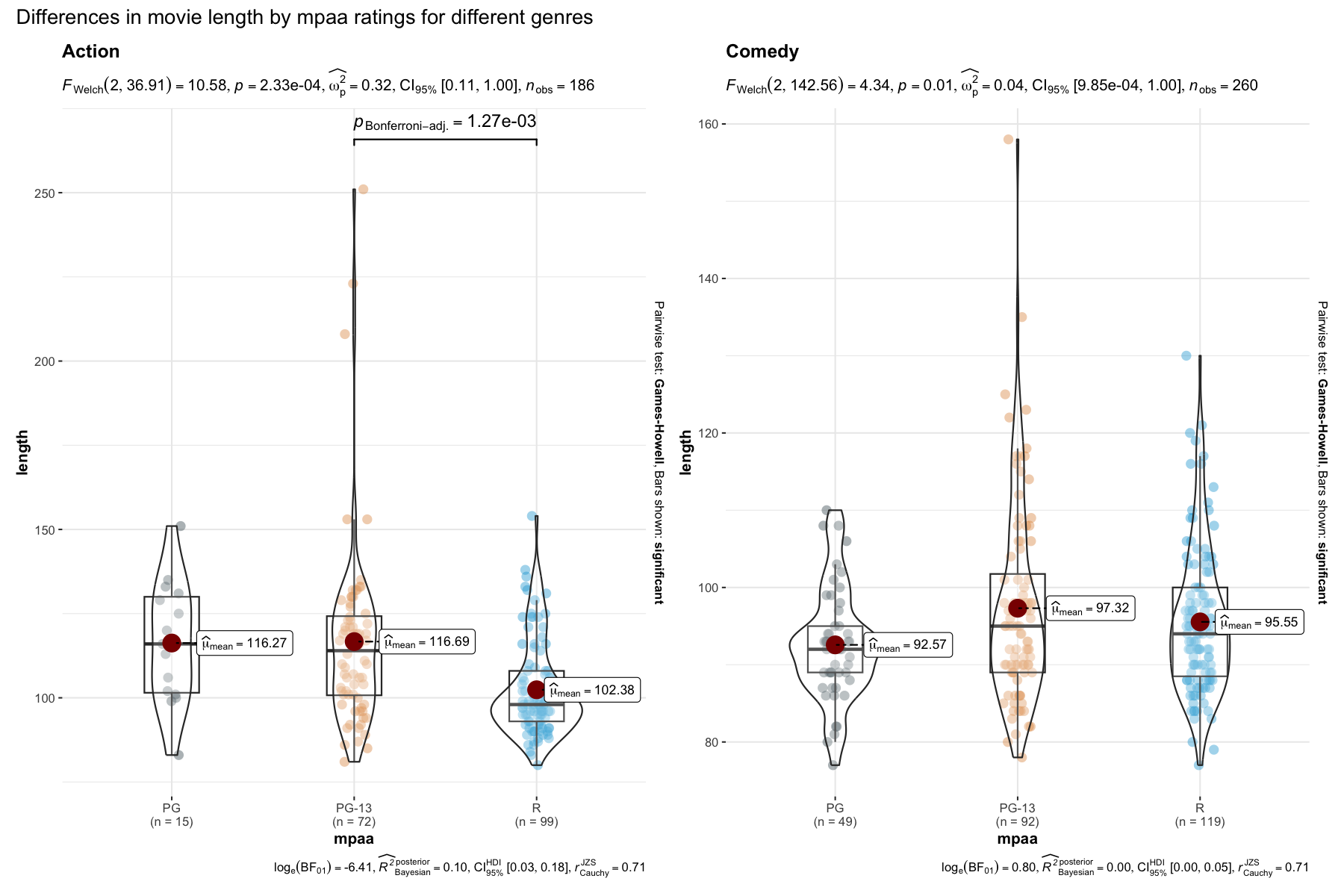
Additionally, there is also a grouped_ variant of this function that
makes it easy to repeat the same operation across a single grouping
variable:
# for reproducibility
set.seed(123)
# plot
grouped_ggbetweenstats(
data = dplyr::filter(
.data = movies_long,
genre %in% c("Action", "Action Comedy", "Action Drama", "Comedy")
),
x = mpaa,
y = length,
grouping.var = genre, # grouping variable
outlier.tagging = TRUE, # whether outliers need to be tagged
outlier.label = title, # variable to be used for tagging outliers
outlier.coef = 2,
ggsignif.args = list(textsize = 4, tip_length = 0.01),
p.adjust.method = "bonferroni", # method for adjusting p-values for multiple comparisons
# adding new components to `ggstatsplot` default
ggplot.component = list(ggplot2::scale_y_continuous(sec.axis = ggplot2::dup_axis())),
caption = substitute(paste(italic("Source"), ": IMDb (Internet Movie Database)")),
palette = "default_jama",
package = "ggsci",
plotgrid.args = list(nrow = 2),
annotation.args = list(title = "Differences in movie length by mpaa ratings for different genres")
)

Note here that the function can be used to tag outliers!
Summary of tests
The central tendency measure displayed will depend on the statistics:
| Type | Measure | Function used |
|---|---|---|
| Parametric | mean | parameters::describe_distribution |
| Non-parametric | median | parameters::describe_distribution |
| Robust | trimmed mean | parameters::describe_distribution |
| Bayesian | MAP estimate | parameters::describe_distribution |
MAP: maximum a posteriori probability
Following (between-subjects) tests are carried out for each type of analyses-
| Type | No. of groups | Test | Function used |
|---|---|---|---|
| Parametric | > 2 | Fisher’s or Welch’s one-way ANOVA | stats::oneway.test |
| Non-parametric | > 2 | Kruskal–Wallis one-way ANOVA | stats::kruskal.test |
| Robust | > 2 | Heteroscedastic one-way ANOVA for trimmed means | WRS2::t1way |
| Bayes Factor | > 2 | Fisher’s ANOVA | BayesFactor::anovaBF |
| Parametric | 2 | Student’s or Welch’s t-test | stats::t.test |
| Non-parametric | 2 | Mann–Whitney U test | stats::wilcox.test |
| Robust | 2 | Yuen’s test for trimmed means | WRS2::yuen |
| Bayesian | 2 | Student’s t-test | BayesFactor::ttestBF |
Following effect sizes (and confidence intervals/CI) are available for each type of test-
Here is a summary of multiple pairwise comparison tests supported in ggbetweenstats-
| Type | Equal variance? | Test | p-value adjustment? | Function used |
|---|---|---|---|---|
| Parametric | No | Games-Howell test | Yes | stats::pairwise.t.test |
| Parametric | Yes | Student’s t-test | Yes | PMCMRplus::gamesHowellTest |
| Non-parametric | No | Dunn test | Yes | PMCMRplus::kwAllPairsDunnTest |
| Robust | No | Yuen’s trimmed means test | Yes | WRS2::lincon |
| Bayes Factor | NA |
Student’s t-test | NA |
BayesFactor::ttestBF |
For more, see the ggbetweenstats vignette:
https://indrajeetpatil.github.io/ggstatsplot/articles/web_only/ggbetweenstats.html
ggwithinstats
ggbetweenstats function has an identical twin function ggwithinstats
for repeated measures designs that behaves in the same fashion with a
few minor tweaks introduced to properly visualize the repeated measures
design. As can be seen from an example below, the only difference
between the plot structure is that now the group means are connected by
paths to highlight the fact that these data are paired with each other.
# for reproducibility and data
set.seed(123)
library(WRS2) # for data
library(afex) # to run anova
# plot
ggwithinstats(
data = WineTasting,
x = Wine,
y = Taste,
title = "Wine tasting",
caption = "Data source: `WRS2` R package",
ggtheme = ggthemes::theme_fivethirtyeight(),
ggstatsplot.layer = FALSE
)
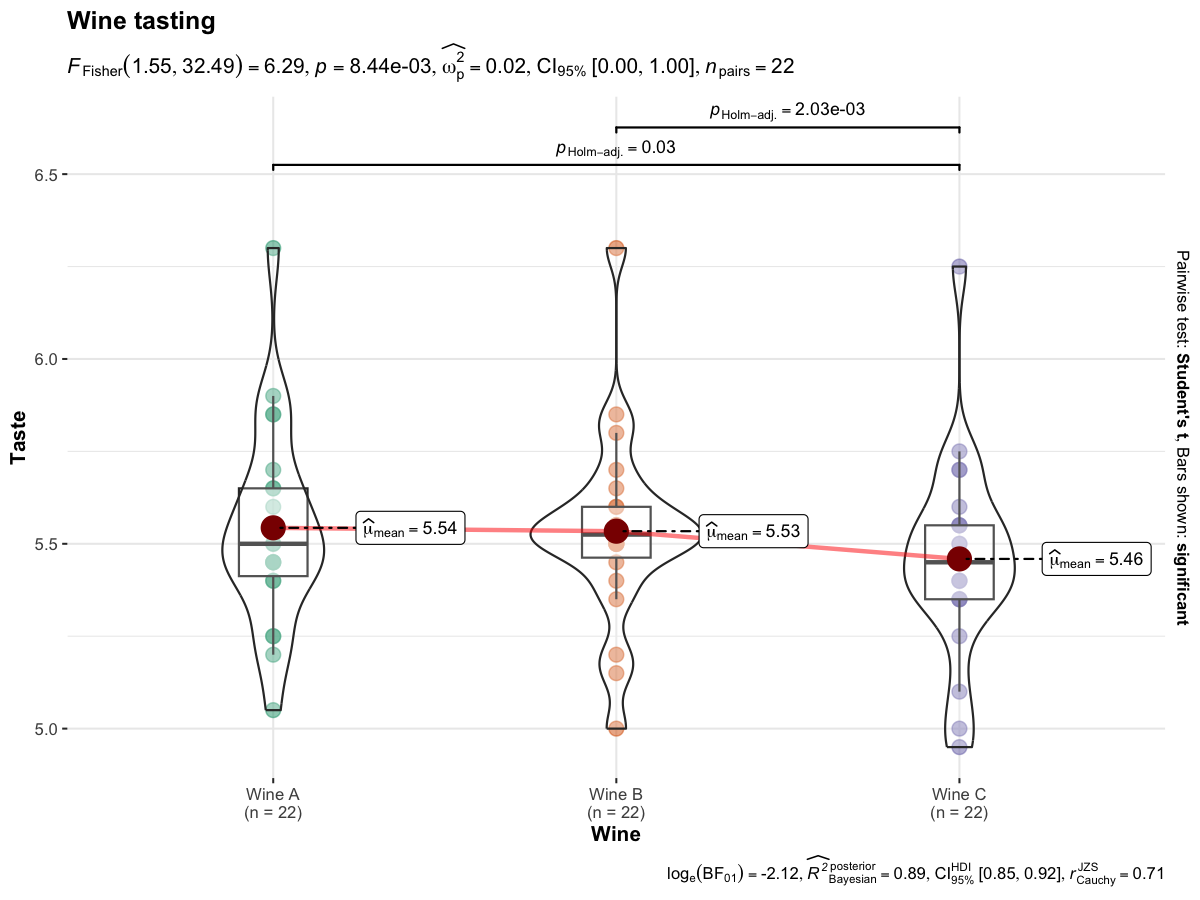
📝 Defaults return
✅ raw data + distributions
✅ descriptive statistics
✅
inferential statistics
✅ effect size + CIs
✅ pairwise
comparisons
✅ Bayesian hypothesis-testing
✅ Bayesian
estimation
The central tendency measure displayed will depend on the statistics:
| Type | Measure | Function used |
|---|---|---|
| Parametric | mean | parameters::describe_distribution |
| Non-parametric | median | parameters::describe_distribution |
| Robust | trimmed mean | parameters::describe_distribution |
| Bayesian | MAP estimate | parameters::describe_distribution |
As with the ggbetweenstats, this function also has a grouped_
variant that makes repeating the same analysis across a single grouping
variable quicker. We will see an example with only repeated
measurements-
# common setup
set.seed(123)
# plot
grouped_ggwithinstats(
data = dplyr::filter(
.data = bugs_long,
region %in% c("Europe", "North America"),
condition %in% c("LDLF", "LDHF")
),
x = condition,
y = desire,
type = "np", # non-parametric statistics
xlab = "Condition",
ylab = "Desire to kill an artrhopod",
grouping.var = region,
outlier.tagging = TRUE,
outlier.label = education
)
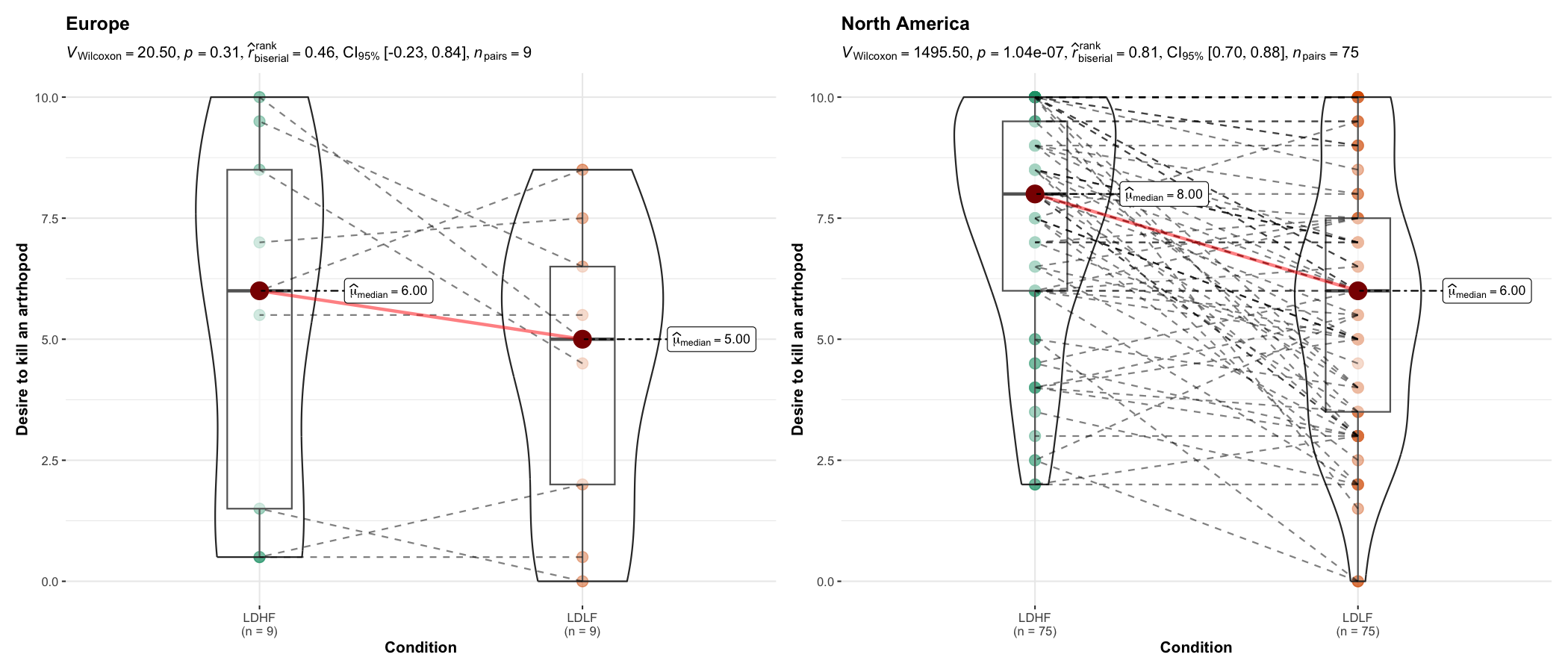
Summary of tests
The central tendency measure displayed will depend on the statistics:
| Type | Measure | Function used |
|---|---|---|
| Parametric | mean | parameters::describe_distribution |
| Non-parametric | median | parameters::describe_distribution |
| Robust | trimmed mean | parameters::describe_distribution |
| Bayesian | MAP estimate | parameters::describe_distribution |
MAP: maximum a posteriori probability
Following (within-subjects) tests are carried out for each type of analyses-
| Type | No. of groups | Test | Function used |
|---|---|---|---|
| Parametric | > 2 | One-way repeated measures ANOVA | afex::aov_ez |
| Non-parametric | > 2 | Friedman rank sum test | stats::friedman.test |
| Robust | > 2 | Heteroscedastic one-way repeated measures ANOVA for trimmed means | WRS2::rmanova |
| Bayes Factor | > 2 | One-way repeated measures ANOVA | BayesFactor::anovaBF |
| Parametric | 2 | Student’s t-test | stats::t.test |
| Non-parametric | 2 | Wilcoxon signed-rank test | stats::wilcox.test |
| Robust | 2 | Yuen’s test on trimmed means for dependent samples | WRS2::yuend |
| Bayesian | 2 | Student’s t-test | BayesFactor::ttestBF |
Following effect sizes (and confidence intervals/CI) are available for each type of test-
Here is a summary of multiple pairwise comparison tests supported in ggwithinstats-
| Type | Test | p-value adjustment? | Function used |
|---|---|---|---|
| Parametric | Student’s t-test | Yes | stats::pairwise.t.test |
| Non-parametric | Durbin-Conover test | Yes | PMCMRplus::durbinAllPairsTest |
| Robust | Yuen’s trimmed means test | Yes | WRS2::rmmcp |
| Bayesian | Student’s t-test | NA |
BayesFactor::ttestBF |
For more, see the ggwithinstats vignette:
https://indrajeetpatil.github.io/ggstatsplot/articles/web_only/ggwithinstats.html
gghistostats
To visualize the distribution of a single variable and check if its mean
is significantly different from a specified value with a one-sample
test, gghistostats can be used.
# for reproducibility
set.seed(123)
# plot
gghistostats(
data = ggplot2::msleep, # dataframe from which variable is to be taken
x = awake, # numeric variable whose distribution is of interest
title = "Amount of time spent awake", # title for the plot
caption = substitute(paste(italic("Source: "), "Mammalian sleep data set")),
test.value = 12, # default value is 0
binwidth = 1, # binwidth value (experiment)
ggtheme = hrbrthemes::theme_ipsum_tw(), # choosing a different theme
ggstatsplot.layer = FALSE # turn off ggstatsplot theme layer
)
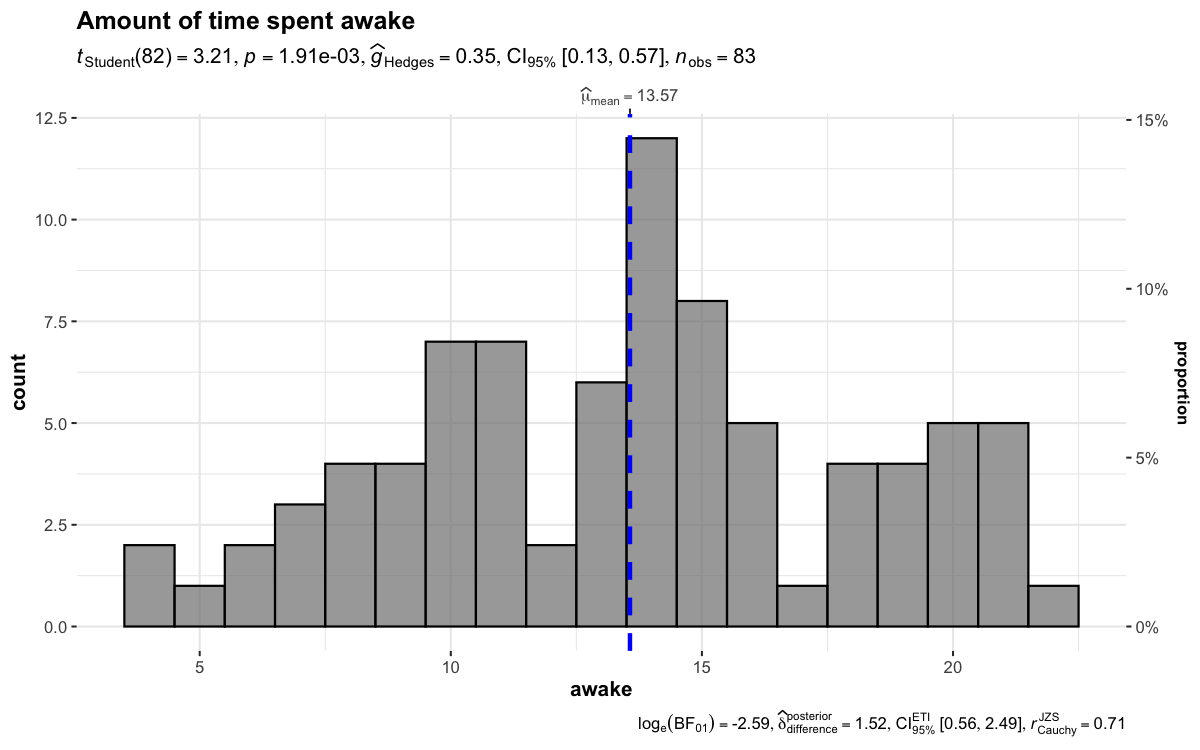
📝 Defaults return
✅ counts + proportion for bins
✅ descriptive statistics
✅
inferential statistics
✅ effect size + CIs
✅ Bayesian
hypothesis-testing
✅ Bayesian estimation
There is also a grouped_ variant of this function that makes it easy
to repeat the same operation across a single grouping variable:
# for reproducibility
set.seed(123)
# plot
grouped_gghistostats(
data = dplyr::filter(
.data = movies_long,
genre %in% c("Action", "Action Comedy", "Action Drama", "Comedy")
),
x = budget,
test.value = 50,
type = "nonparametric",
xlab = "Movies budget (in million US$)",
grouping.var = genre, # grouping variable
normal.curve = TRUE, # superimpose a normal distribution curve
normal.curve.args = list(color = "red", size = 1),
ggtheme = ggthemes::theme_tufte(),
# modify the defaults from `ggstatsplot` for each plot
ggplot.component = ggplot2::labs(caption = "Source: IMDB.com"),
plotgrid.args = list(nrow = 2),
annotation.args = list(title = "Movies budgets for different genres")
)
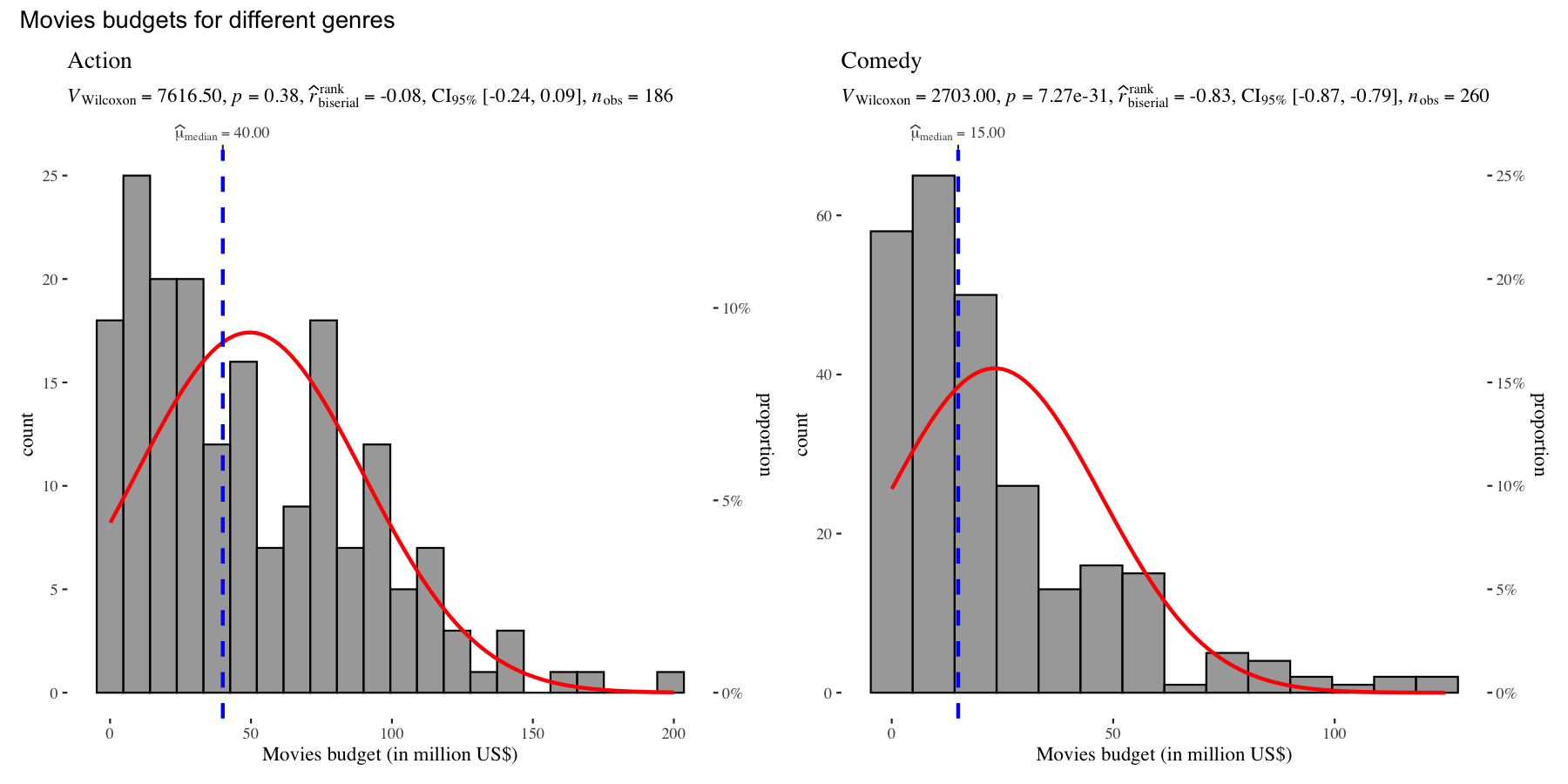
Summary of tests
The central tendency measure displayed will depend on the statistics:
| Type | Measure | Function used |
|---|---|---|
| Parametric | mean | parameters::describe_distribution |
| Non-parametric | median | parameters::describe_distribution |
| Robust | trimmed mean | parameters::describe_distribution |
| Bayesian | MAP estimate | parameters::describe_distribution |
Following tests are carried out for each type of analyses-
| Type | Test | Function used |
|---|---|---|
| Parametric | One-sample Student’s t-test | stats::t.test |
| Non-parametric | One-sample Wilcoxon test | stats::wilcox.test |
| Robust | Bootstrap-t method for one-sample test |
trimcibt (custom) |
| Bayesian | One-sample Student’s t-test | BayesFactor::ttestBF |
Following effect sizes (and confidence intervals/CI) are available for each type of test-
For more, including information about the variant of this function
grouped_gghistostats, see the gghistostats vignette:
https://indrajeetpatil.github.io/ggstatsplot/articles/web_only/gghistostats.html
ggdotplotstats
This function is similar to gghistostats, but is intended to be used
when the numeric variable also has a label.
# for reproducibility
set.seed(123)
# plot
ggdotplotstats(
data = dplyr::filter(.data = gapminder::gapminder, continent == "Asia"),
y = country,
x = lifeExp,
test.value = 55,
type = "robust",
title = "Distribution of life expectancy in Asian continent",
xlab = "Life expectancy",
caption = substitute(
paste(
italic("Source"),
": Gapminder dataset from https://www.gapminder.org/"
)
)
)
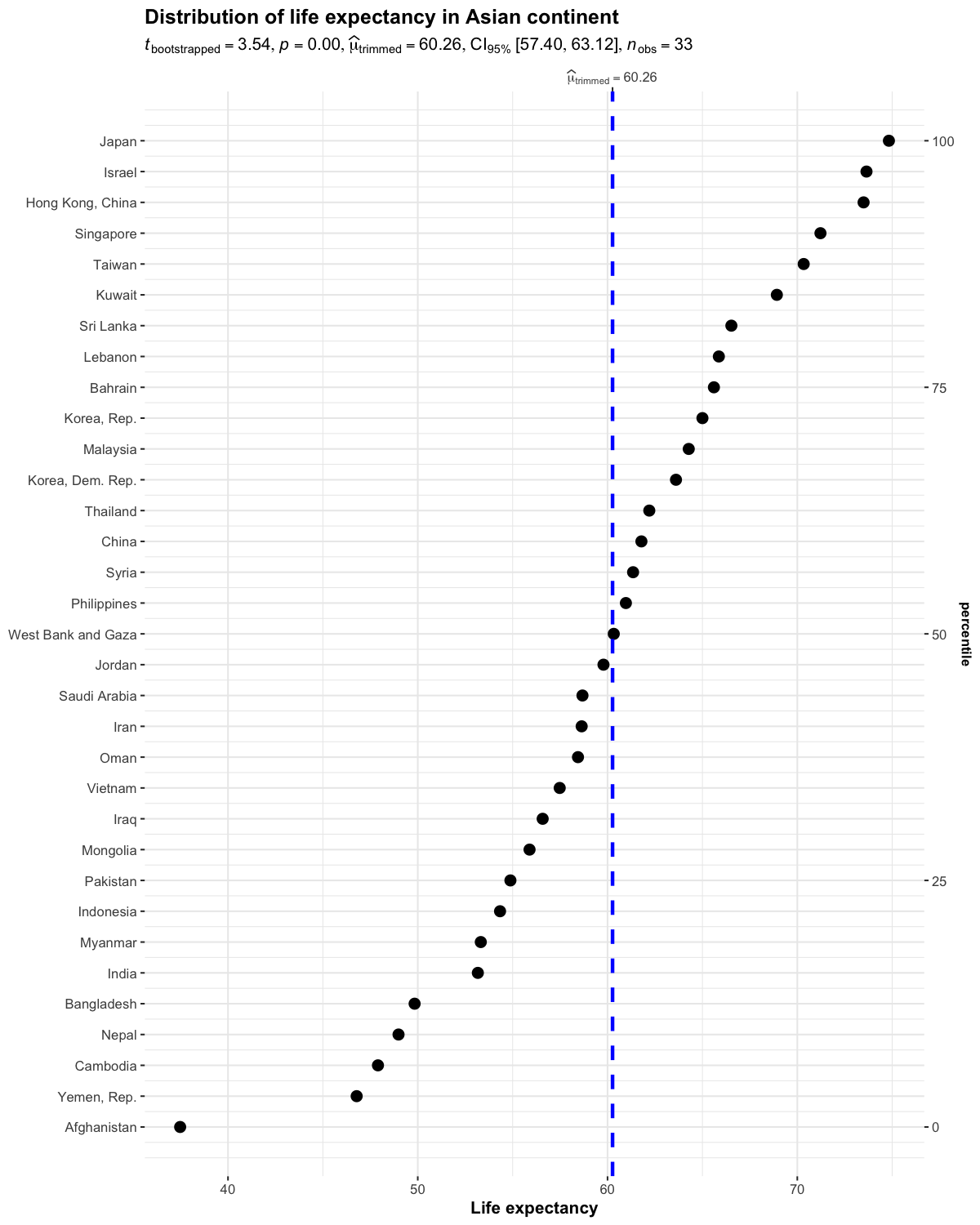
📝 Defaults return
✅ descriptives (mean + sample size)
✅ inferential statistics
✅
effect size + CIs
✅ Bayesian hypothesis-testing
✅ Bayesian
estimation
As with the rest of the functions in this package, there is also a
grouped_ variant of this function to facilitate looping the same
operation for all levels of a single grouping variable.
# for reproducibility
set.seed(123)
# plot
grouped_ggdotplotstats(
data = dplyr::filter(.data = ggplot2::mpg, cyl %in% c("4", "6")),
x = cty,
y = manufacturer,
type = "bayes", # Bayesian test
xlab = "city miles per gallon",
ylab = "car manufacturer",
grouping.var = cyl, # grouping variable
test.value = 15.5,
point.args = list(color = "red", size = 5, shape = 13),
annotation.args = list(title = "Fuel economy data")
)
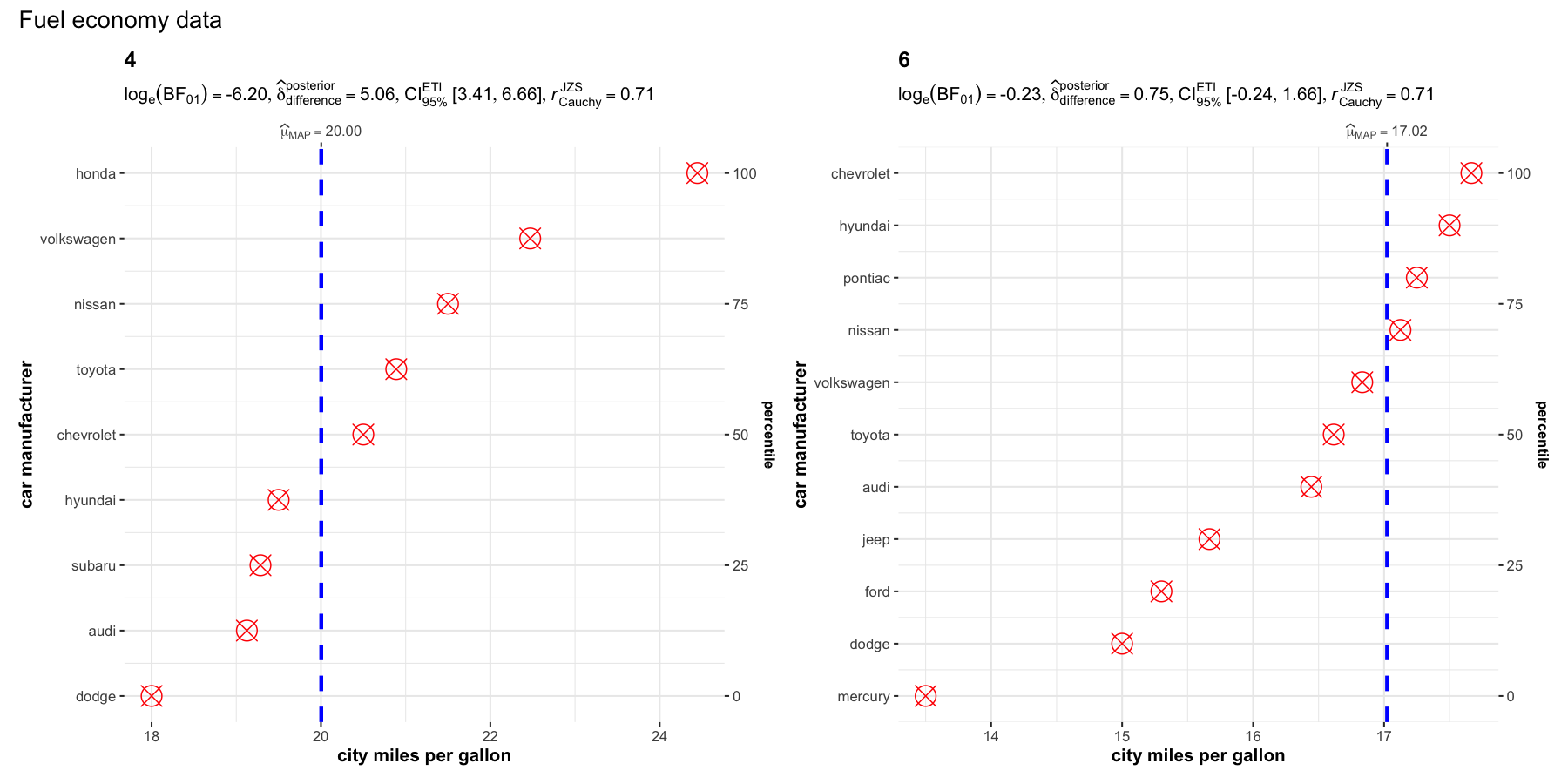
Summary of tests
This is identical to summary of tests for gghistostats.
ggscatterstats
This function creates a scatterplot with marginal distributions overlaid
on the axes (from ggExtra::ggMarginal) and results from statistical
tests in the subtitle:
ggscatterstats(
data = ggplot2::msleep,
x = sleep_rem,
y = awake,
xlab = "REM sleep (in hours)",
ylab = "Amount of time spent awake (in hours)",
title = "Understanding mammalian sleep"
)
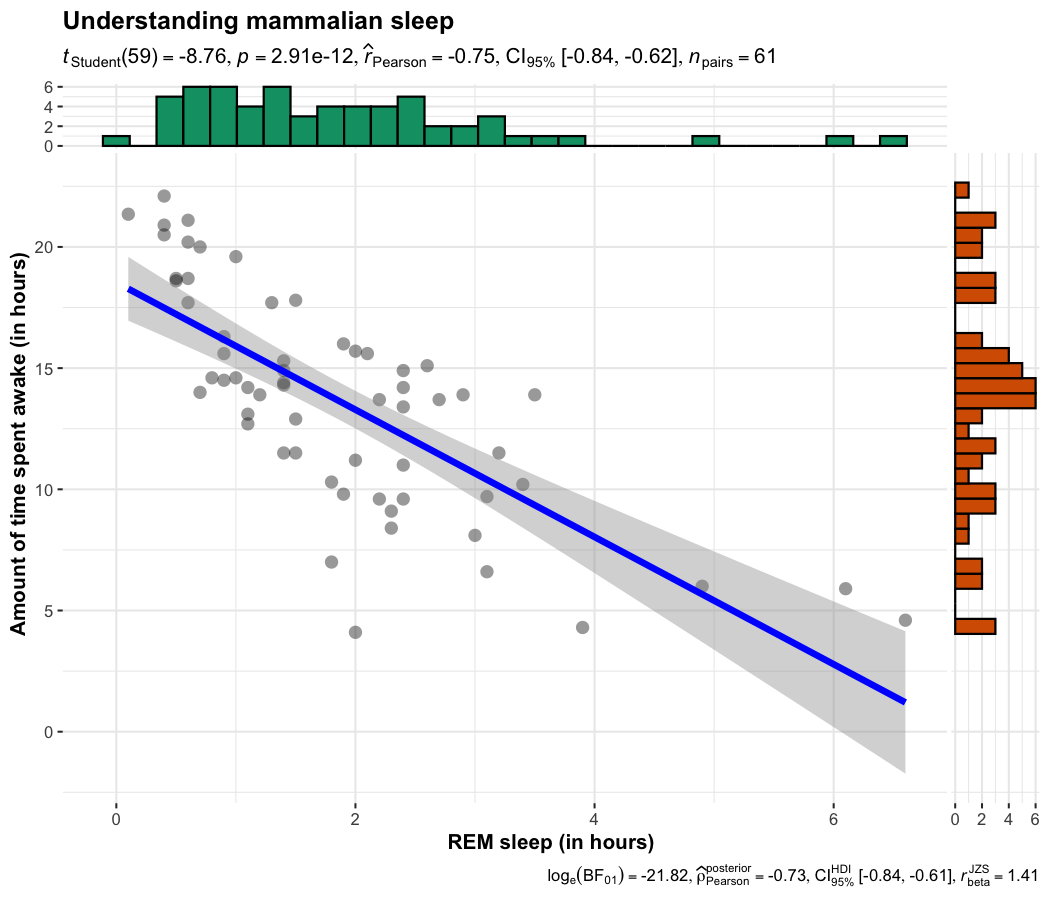
📝 Defaults return
✅ raw data + distributions
✅ marginal distributions
✅
inferential statistics
✅ effect size + CIs
✅ Bayesian
hypothesis-testing
✅ Bayesian estimation
The available marginal distributions are-
- histograms
- boxplots
- density
- violin
- densigram (density + histogram)
Number of other arguments can be specified to modify this basic plot-
# for reproducibility
set.seed(123)
# plot
ggscatterstats(
data = dplyr::filter(.data = movies_long, genre == "Action"),
x = budget,
y = rating,
type = "robust", # type of test that needs to be run
xlab = "Movie budget (in million/ US$)", # label for x axis
ylab = "IMDB rating", # label for y axis
label.var = title, # variable for labeling data points
label.expression = rating < 5 & budget > 100, # expression that decides which points to label
title = "Movie budget and IMDB rating (action)", # title text for the plot
caption = expression(paste(italic("Note"), ": IMDB stands for Internet Movie DataBase")),
ggtheme = hrbrthemes::theme_ipsum_ps(), # choosing a different theme
ggstatsplot.layer = FALSE, # turn off `ggstatsplot` theme layer
marginal.type = "boxplot", # type of marginal distribution to be displayed
xfill = "pink", # color fill for x-axis marginal distribution
yfill = "#009E73" # color fill for y-axis marginal distribution
)

Additionally, there is also a grouped_ variant of this function that
makes it easy to repeat the same operation across a single grouping
variable. Also, note that, as opposed to the other functions, this
function does not return a ggplot object and any modification you want
to make can be made in advance using ggplot.component argument
(available for all functions, but especially useful here):
# for reproducibility
set.seed(123)
# plot
grouped_ggscatterstats(
data = dplyr::filter(
.data = movies_long,
genre %in% c("Action", "Action Comedy", "Action Drama", "Comedy")
),
x = rating,
y = length,
grouping.var = genre, # grouping variable
label.var = title,
label.expression = length > 200,
xlab = "IMDB rating",
ggtheme = ggplot2::theme_grey(),
ggplot.component = list(
ggplot2::scale_x_continuous(breaks = seq(2, 9, 1), limits = (c(2, 9)))
),
plotgrid.args = list(nrow = 2),
annotation.args = list(title = "Relationship between movie length by IMDB ratings for different genres")
)

Summary of tests
Following tests are carried out for each type of analyses. Additionally, the correlation coefficients (and their confidence intervals) are used as effect sizes-
| Type | Test | CI? | Function used |
|---|---|---|---|
| Parametric | Pearson’s correlation coefficient | Yes | correlation::correlation |
| Non-parametric | Spearman’s rank correlation coefficient | Yes | correlation::correlation |
| Robust | Winsorized Pearson correlation coefficient | Yes | correlation::correlation |
| Bayesian | Pearson’s correlation coefficient | Yes | correlation::correlation |
For more, see the ggscatterstats vignette:
https://indrajeetpatil.github.io/ggstatsplot/articles/web_only/ggscatterstats.html
ggcorrmat
ggcorrmat makes a correlalogram (a matrix of correlation coefficients)
with minimal amount of code. Just sticking to the defaults itself
produces publication-ready correlation matrices. But, for the sake of
exploring the available options, let’s change some of the defaults. For
example, multiple aesthetics-related arguments can be modified to change
the appearance of the correlation matrix.
# for reproducibility
set.seed(123)
# as a default this function outputs a correlation matrix plot
ggcorrmat(
data = ggplot2::msleep,
colors = c("#B2182B", "white", "#4D4D4D"),
title = "Correlalogram for mammals sleep dataset",
subtitle = "sleep units: hours; weight units: kilograms"
)
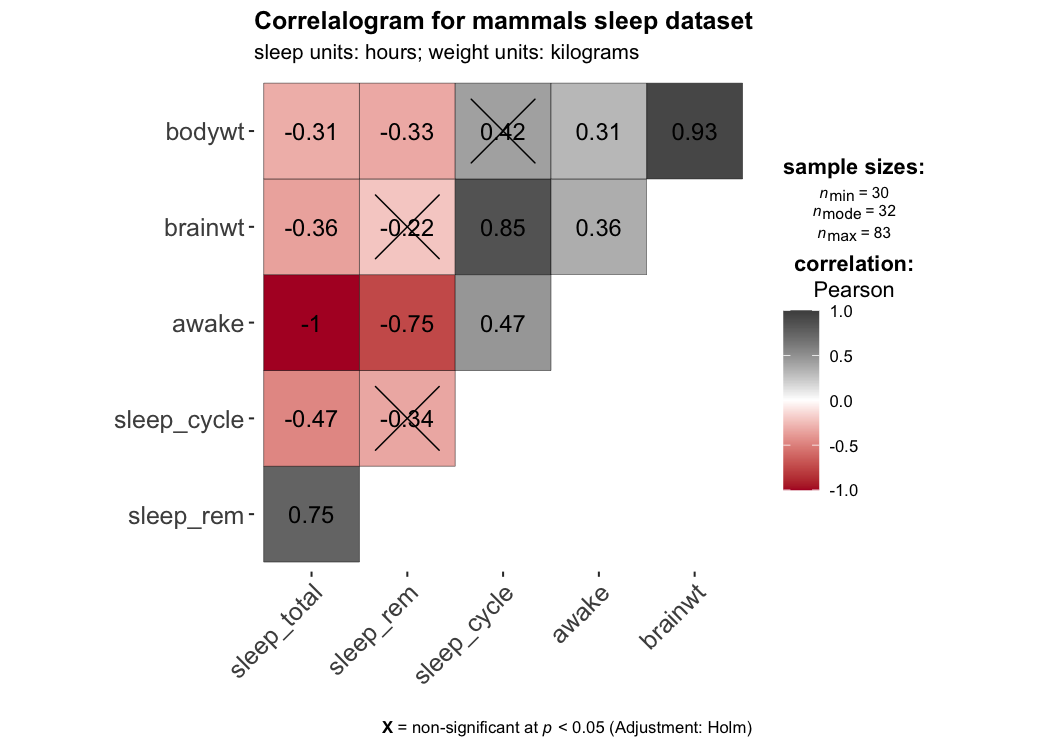
📝 Defaults return
✅ effect size + significance
✅ careful handling of NAs
If there are NAs present in the selected variables, the legend will
display minimum, median, and maximum number of pairs used for
correlation tests.
There is also a grouped_ variant of this function that makes it easy
to repeat the same operation across a single grouping variable:
# for reproducibility
set.seed(123)
# plot
grouped_ggcorrmat(
data = dplyr::filter(
.data = movies_long,
genre %in% c("Action", "Action Comedy", "Action Drama", "Comedy")
),
type = "robust", # correlation method
colors = c("#cbac43", "white", "#550000"),
grouping.var = genre, # grouping variable
matrix.type = "lower" # type of matrix
)
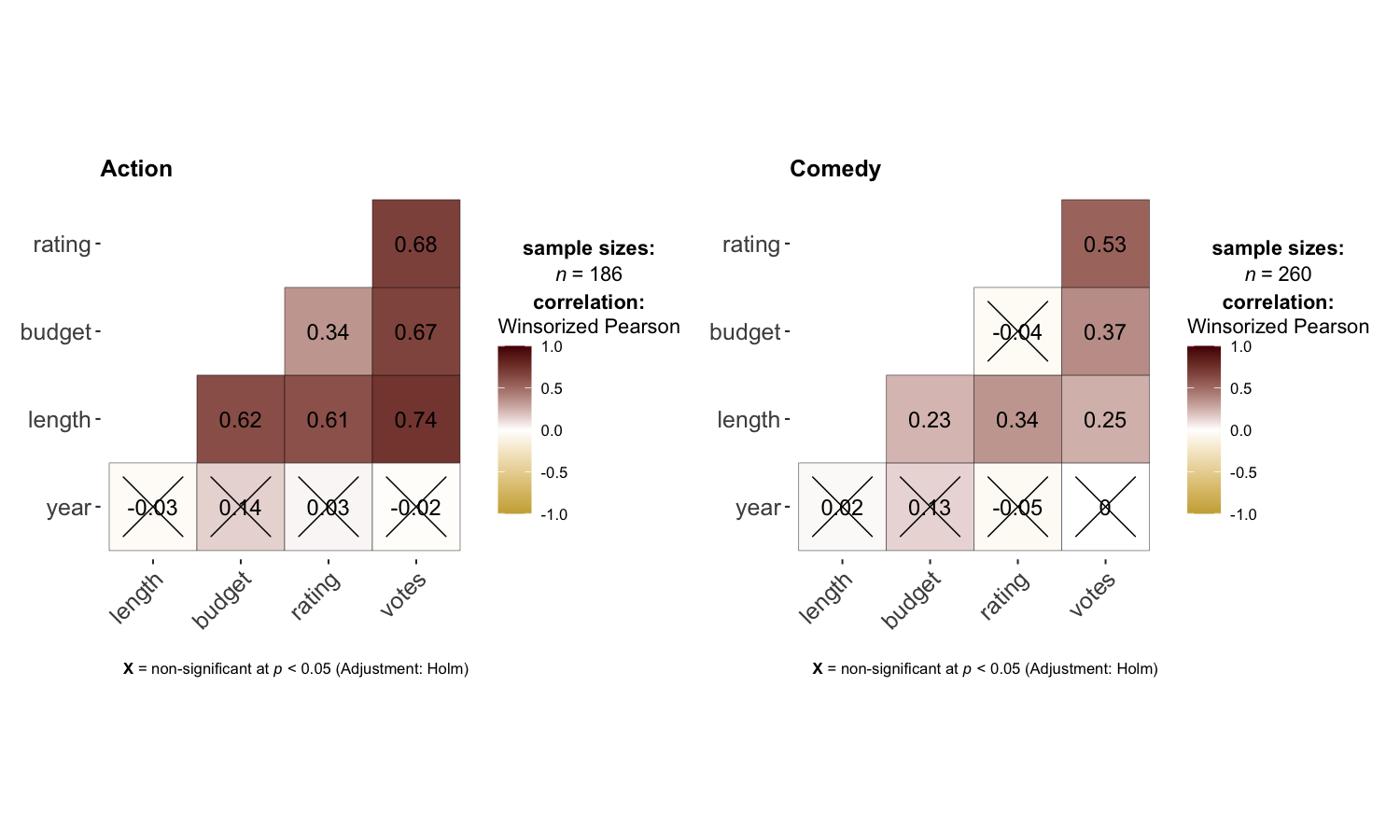
You can also get a dataframe containing all relevant details from the statistical tests:
# setup
set.seed(123)
# dataframe in long format
ggcorrmat(
data = ggplot2::msleep,
type = "bayes",
output = "dataframe"
)
#> # A tibble: 15 x 14
#> parameter1 parameter2 estimate conf.level conf.low conf.high pd
#> <chr> <chr> <dbl> <dbl> <dbl> <dbl> <dbl>
#> 1 sleep_total sleep_rem 0.731 0.95 0.617 0.810 1
#> 2 sleep_total sleep_cycle -0.432 0.95 -0.678 -0.223 0.995
#> 3 sleep_total awake -1.00 0.95 -1.00 -1.00 1
#> 4 sleep_total brainwt -0.339 0.95 -0.523 -0.156 0.996
#> 5 sleep_total bodywt -0.300 0.95 -0.458 -0.142 0.997
#> 6 sleep_rem sleep_cycle -0.306 0.95 -0.535 -0.0555 0.965
#> 7 sleep_rem awake -0.734 0.95 -0.824 -0.638 1
#> 8 sleep_rem brainwt -0.202 0.95 -0.410 0.0130 0.927
#> 9 sleep_rem bodywt -0.315 0.95 -0.481 -0.120 0.994
#> 10 sleep_cycle awake 0.441 0.95 0.226 0.662 0.995
#> 11 sleep_cycle brainwt 0.823 0.95 0.720 0.911 1
#> 12 sleep_cycle bodywt 0.386 0.95 0.145 0.610 0.992
#> 13 awake brainwt 0.341 0.95 0.154 0.524 0.992
#> 14 awake bodywt 0.299 0.95 0.139 0.454 0.998
#> 15 brainwt bodywt 0.926 0.95 0.896 0.957 1
#> rope.percentage prior.distribution prior.location prior.scale bayes.factor
#> <dbl> <chr> <dbl> <dbl> <dbl>
#> 1 0 beta 1.41 1.41 3.00e+ 9
#> 2 0.0173 beta 1.41 1.41 8.85e+ 0
#> 3 0 beta 1.41 1.41 NA
#> 4 0.028 beta 1.41 1.41 7.29e+ 0
#> 5 0.0292 beta 1.41 1.41 9.28e+ 0
#> 6 0.091 beta 1.41 1.41 1.42e+ 0
#> 7 0 beta 1.41 1.41 3.01e+ 9
#> 8 0.212 beta 1.41 1.41 6.54e- 1
#> 9 0.0362 beta 1.41 1.41 4.80e+ 0
#> 10 0.0158 beta 1.41 1.41 8.85e+ 0
#> 11 0 beta 1.41 1.41 3.80e+ 6
#> 12 0.0392 beta 1.41 1.41 3.76e+ 0
#> 13 0.0253 beta 1.41 1.41 7.29e+ 0
#> 14 0.0265 beta 1.41 1.41 9.27e+ 0
#> 15 0 beta 1.41 1.41 1.58e+22
#> method n.obs
#> <chr> <int>
#> 1 Bayesian Pearson correlation 61
#> 2 Bayesian Pearson correlation 32
#> 3 Bayesian Pearson correlation 83
#> 4 Bayesian Pearson correlation 56
#> 5 Bayesian Pearson correlation 83
#> 6 Bayesian Pearson correlation 32
#> 7 Bayesian Pearson correlation 61
#> 8 Bayesian Pearson correlation 48
#> 9 Bayesian Pearson correlation 61
#> 10 Bayesian Pearson correlation 32
#> 11 Bayesian Pearson correlation 30
#> 12 Bayesian Pearson correlation 32
#> 13 Bayesian Pearson correlation 56
#> 14 Bayesian Pearson correlation 83
#> 15 Bayesian Pearson correlation 56
Additionally, partial correlation are also supported:
# setup
set.seed(123)
# dataframe in long format
ggcorrmat(
data = ggplot2::msleep,
type = "bayes",
partial = TRUE,
output = "dataframe"
)
#> # A tibble: 15 x 14
#> parameter1 parameter2 estimate conf.level conf.low conf.high pd
#> <chr> <chr> <dbl> <dbl> <dbl> <dbl> <dbl>
#> 1 sleep_total sleep_rem 0.279 0.95 0.0202 0.550 0.940
#> 2 sleep_total sleep_cycle -0.0181 0.95 -0.306 0.254 0.543
#> 3 sleep_total awake -1 0.95 -1 -1 1
#> 4 sleep_total brainwt -0.0818 0.95 -0.352 0.192 0.678
#> 5 sleep_total bodywt -0.163 0.95 -0.425 0.121 0.818
#> 6 sleep_rem sleep_cycle -0.0666 0.95 -0.335 0.222 0.643
#> 7 sleep_rem awake 0.0505 0.95 -0.212 0.328 0.611
#> 8 sleep_rem brainwt 0.0811 0.95 -0.235 0.326 0.668
#> 9 sleep_rem bodywt -0.0190 0.95 -0.296 0.265 0.544
#> 10 sleep_cycle awake -0.00603 0.95 -0.278 0.279 0.516
#> 11 sleep_cycle brainwt 0.764 0.95 0.637 0.871 1
#> 12 sleep_cycle bodywt -0.0865 0.95 -0.351 0.187 0.691
#> 13 awake brainwt -0.0854 0.95 -0.349 0.205 0.690
#> 14 awake bodywt -0.407 0.95 -0.630 -0.146 0.991
#> 15 brainwt bodywt 0.229 0.95 -0.0341 0.484 0.904
#> rope.percentage prior.distribution prior.location prior.scale bayes.factor
#> <dbl> <chr> <dbl> <dbl> <dbl>
#> 1 0.133 beta 1.41 1.41 1.04
#> 2 0.418 beta 1.41 1.41 0.277
#> 3 0 beta 1.41 1.41 NA
#> 4 0.390 beta 1.41 1.41 0.311
#> 5 0.294 beta 1.41 1.41 0.417
#> 6 0.404 beta 1.41 1.41 0.297
#> 7 0.411 beta 1.41 1.41 0.287
#> 8 0.380 beta 1.41 1.41 0.303
#> 9 0.424 beta 1.41 1.41 0.280
#> 10 0.422 beta 1.41 1.41 0.276
#> 11 0 beta 1.41 1.41 131029.
#> 12 0.393 beta 1.41 1.41 0.309
#> 13 0.390 beta 1.41 1.41 0.310
#> 14 0.033 beta 1.41 1.41 4.82
#> 15 0.206 beta 1.41 1.41 0.637
#> method n.obs
#> <chr> <int>
#> 1 Bayesian Pearson correlation 30
#> 2 Bayesian Pearson correlation 30
#> 3 Bayesian Pearson correlation 30
#> 4 Bayesian Pearson correlation 30
#> 5 Bayesian Pearson correlation 30
#> 6 Bayesian Pearson correlation 30
#> 7 Bayesian Pearson correlation 30
#> 8 Bayesian Pearson correlation 30
#> 9 Bayesian Pearson correlation 30
#> 10 Bayesian Pearson correlation 30
#> 11 Bayesian Pearson correlation 30
#> 12 Bayesian Pearson correlation 30
#> 13 Bayesian Pearson correlation 30
#> 14 Bayesian Pearson correlation 30
#> 15 Bayesian Pearson correlation 30
Summary of tests
| Type | Test | CI? | partial? | Function used |
|---|---|---|---|---|
| Parametric | Pearson’s correlation coefficient | Yes | Yes | correlation::correlation |
| Non-parametric | Spearman’s rank correlation coefficient | Yes | Yes | correlation::correlation |
| Robust | Winsorized Pearson correlation coefficient | Yes | Yes | correlation::correlation |
| Bayesian | Pearson’s correlation coefficient | Yes | Yes | correlation::correlation |
For examples and more information, see the ggcorrmat vignette:
https://indrajeetpatil.github.io/ggstatsplot/articles/web_only/ggcorrmat.html
ggpiestats
This function creates a pie chart for categorical or nominal variables with results from contingency table analysis (Pearson’s chi-squared test for between-subjects design and McNemar’s chi-squared test for within-subjects design) included in the subtitle of the plot. If only one categorical variable is entered, results from one-sample proportion test (i.e., a chi-squared goodness of fit test) will be displayed as a subtitle.
To study an interaction between two categorical variables:
# for reproducibility
set.seed(123)
# plot
ggpiestats(
data = mtcars,
x = am,
y = cyl,
title = "Dataset: Motor Trend Car Road Tests", # title for the plot
legend.title = "Transmission", # title for the legend
caption = substitute(paste(italic("Source"), ": 1974 Motor Trend US magazine"))
)
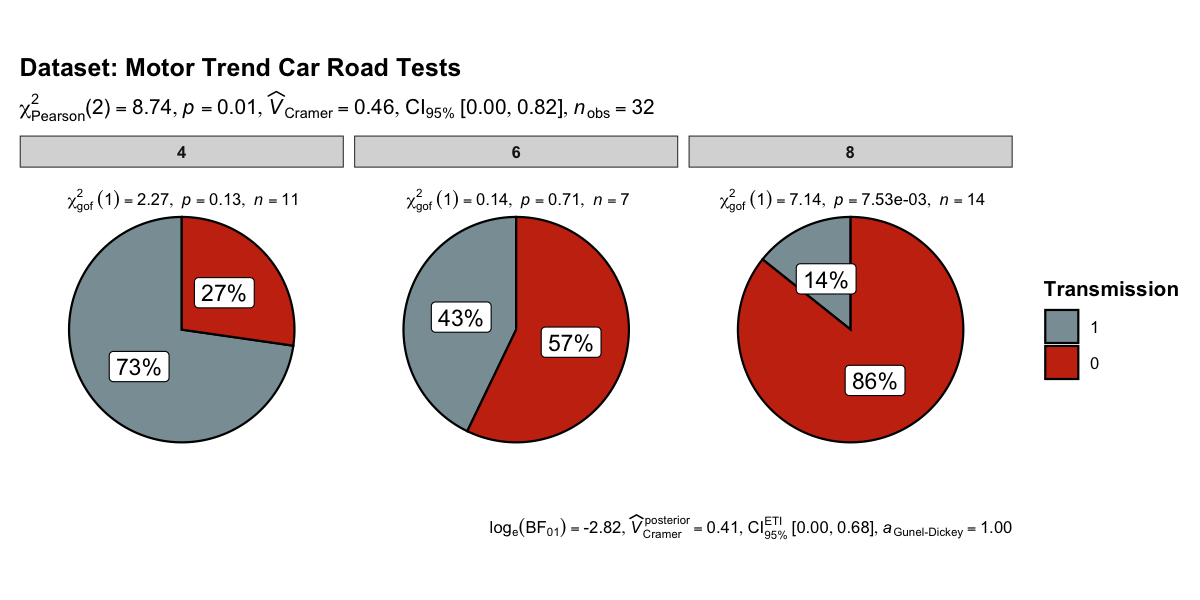
📝 Defaults return
✅ descriptives (frequency + %s)
✅ inferential statistics
✅
effect size + CIs
✅ Goodness-of-fit tests
✅ Bayesian
hypothesis-testing
✅ Bayesian estimation
In case of repeated measures designs, setting paired = TRUE will
produce results from McNemar’s chi-squared test-
# for reproducibility
set.seed(123)
# data
df_paired <-
data.frame(
"before" = c("Approve", "Approve", "Disapprove", "Disapprove"),
"after" = c("Approve", "Disapprove", "Approve", "Disapprove"),
counts = c(794, 150, 86, 570),
check.names = FALSE
)
# plot
ggpiestats(
data = df_paired,
x = before,
y = after,
counts = counts,
title = "Survey results before and after the intervention",
label = "both",
paired = TRUE, # within-subjects design
package = "wesanderson",
palette = "Royal1"
)

Additionally, there is also a grouped_ variant of this function that
makes it easy to repeat the same operation across a single grouping
variable. Following example is a case where the theoretical question is
about proportions for different levels of a single nominal variable:
# for reproducibility
set.seed(123)
# plot
grouped_ggpiestats(
data = movies_long,
x = genre,
grouping.var = mpaa, # grouping variable
label.repel = TRUE, # repel labels (helpful for overlapping labels)
package = "ggsci", # package from which color palette is to be taken
palette = "default_ucscgb", # choosing a different color palette
annotation.args = list(title = "Composition of MPAA ratings for different genres"),
plotgrid.args = list(nrow = 2)
)

Summary of tests
Following tests are carried out for each type of analyses-
Following effect sizes (and confidence intervals/CI) are available for each type of test-
| Test | Effect size | CI? | Function used |
|---|---|---|---|
| Pearson’s |
Cramer’s |
Yes | effectsize::cramers_v |
| McNemar’s test | Cohen’s |
Yes | effectsize::cohens_g |
| Goodness of fit | Cramer’s |
Yes | effectsize::cramers_v |
For more, see the ggpiestats vignette:
https://indrajeetpatil.github.io/ggstatsplot/articles/web_only/ggpiestats.html
ggbarstats
In case you are not a fan of pie charts (for very good reasons), you can
alternatively use ggbarstats function which has a similar syntax.
N.B. The p-values from one-sample proportion test are displayed on top of each bar.
# for reproducibility
set.seed(123)
library(ggplot2)
# plot
ggbarstats(
data = movies_long,
x = mpaa,
y = genre,
title = "MPAA Ratings by Genre",
xlab = "movie genre",
legend.title = "MPAA rating",
ggtheme = hrbrthemes::theme_ipsum_pub(),
ggplot.component = list(ggplot2::scale_x_discrete(guide = ggplot2::guide_axis(n.dodge = 2))),
palette = "Set2"
)
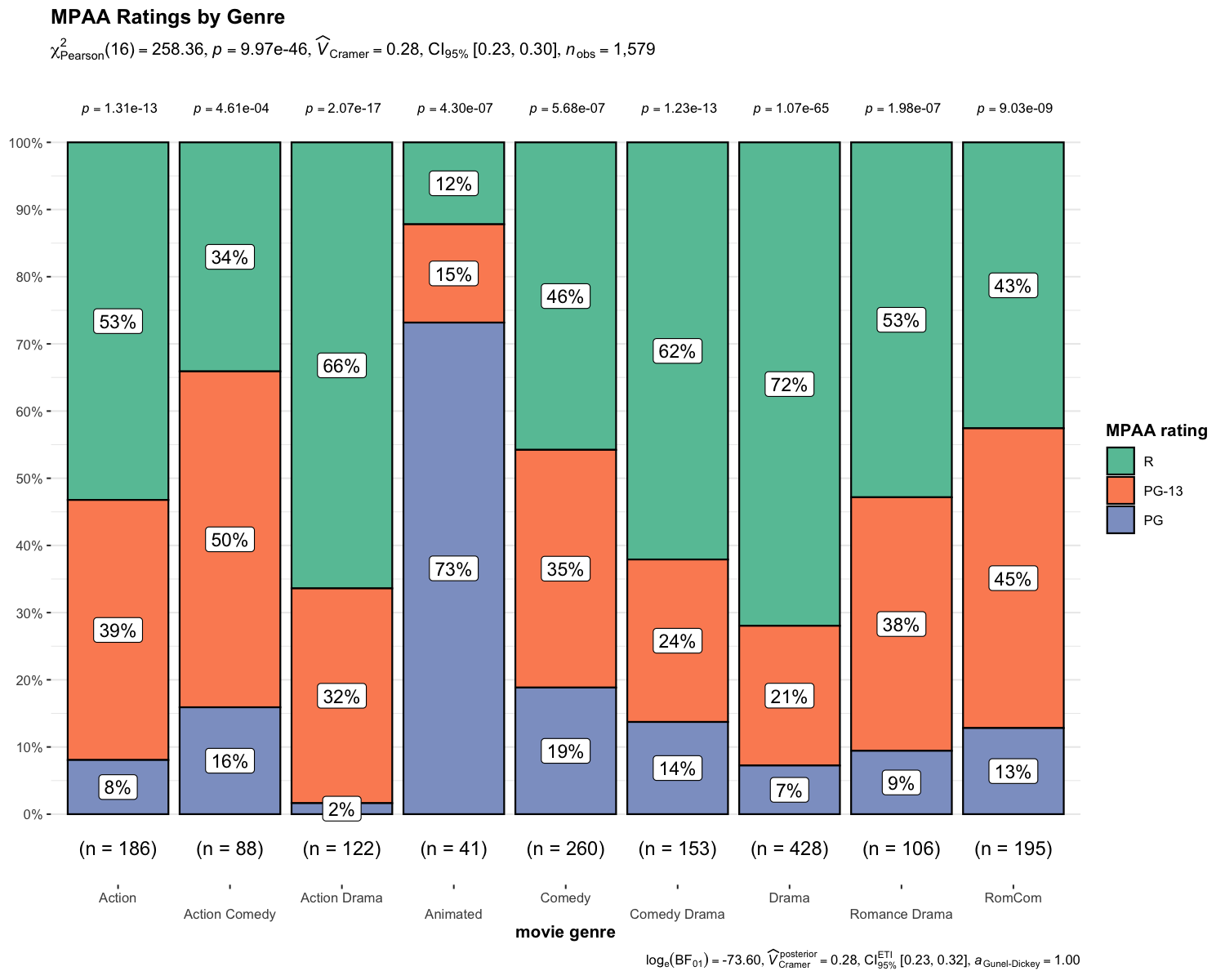
📝 Defaults return
✅ descriptives (frequency + %s)
✅ inferential statistics
✅
effect size + CIs
✅ Goodness-of-fit tests
✅ Bayesian
hypothesis-testing
✅ Bayesian estimation
And, needless to say, there is also a grouped_ variant of this
function-
# setup
set.seed(123)
# smaller dataset
df <-
dplyr::filter(
.data = forcats::gss_cat,
race %in% c("Black", "White"),
relig %in% c("Protestant", "Catholic", "None"),
!partyid %in% c("No answer", "Don't know", "Other party")
)
# plot
grouped_ggbarstats(
data = df,
x = relig,
y = partyid,
grouping.var = race,
label = "both",
xlab = "Party affiliation",
package = "wesanderson",
palette = "Darjeeling2",
ggtheme = ggthemes::theme_tufte(base_size = 12),
ggstatsplot.layer = FALSE,
annotation.args = list(title = "Race, religion, and political affiliation"),
plotgrid.args = list(nrow = 2)
)
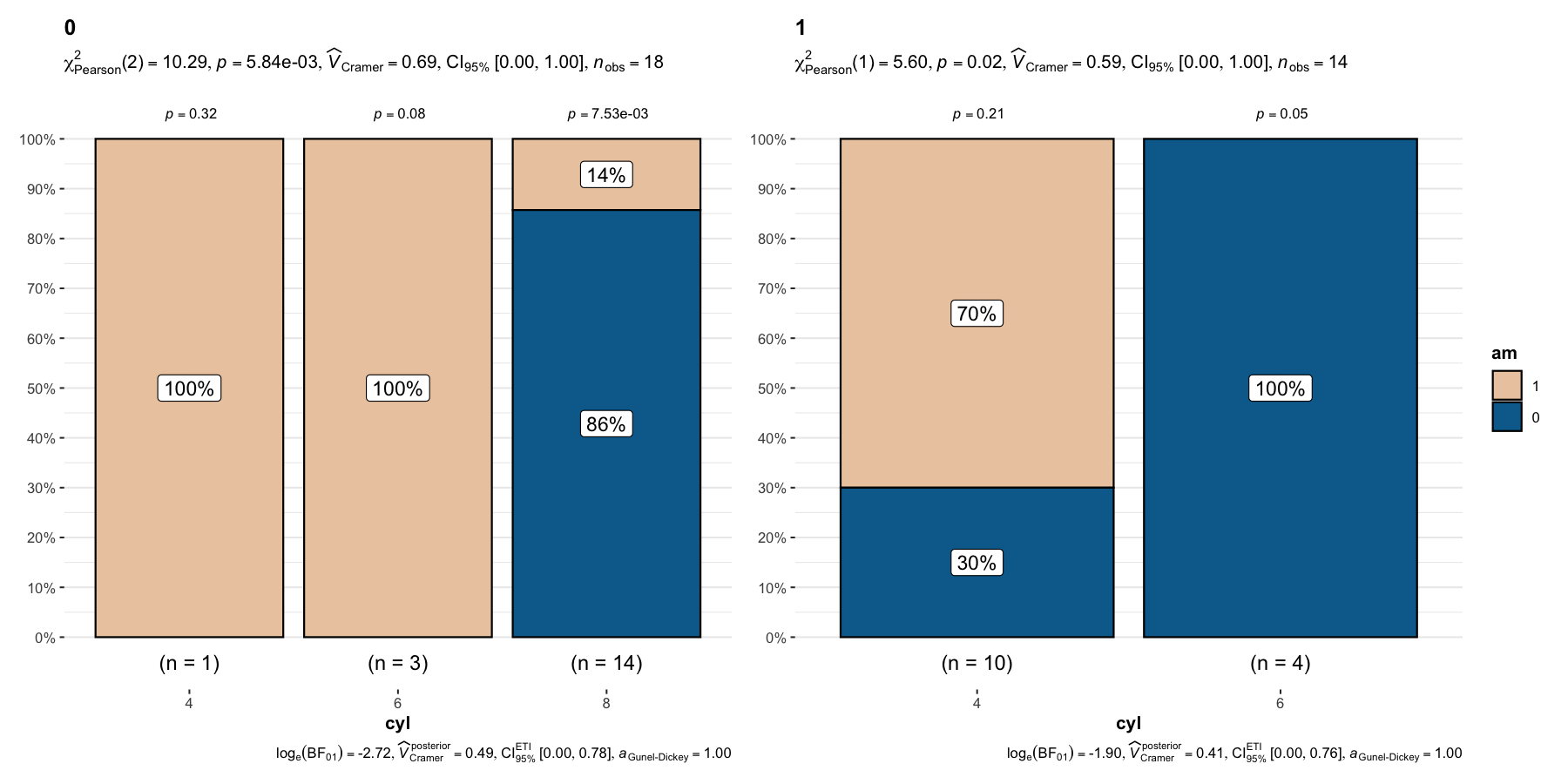
Summary of tests
This is identical to the ggpiestats function summary of tests.
ggcoefstats
The function ggcoefstats generates dot-and-whisker plots for
regression models saved in a tidy data frame. The tidy dataframes are
prepared using parameters::model_parameters. Additionally, if
available, the model summary indices are also extracted from
performance::model_performance.
Although the statistical models displayed in the plot may differ based on the class of models being investigated, there are few aspects of the plot that will be invariant across models:
-
The dot-whisker plot contains a dot representing the estimate and their confidence intervals (
95%is the default). The estimate can either be effect sizes (for tests that depend on theFstatistic) or regression coefficients (for tests withtandzstatistic), etc. The function will, by default, display a helpfulx-axis label that should clear up what estimates are being displayed. The confidence intervals can sometimes be asymmetric if bootstrapping was used. -
The caption will always contain diagnostic information, if available, about models that can be useful for model selection: The smaller the Akaike’s Information Criterion (AIC) and the Bayesian Information Criterion (BIC) values, the “better” the model is.
-
The output of this function will be a
ggplot2object and, thus, it can be further modified (e.g., change themes, etc.) withggplot2functions.
# for reproducibility
set.seed(123)
# model
mod <- stats::lm(formula = mpg ~ am * cyl, data = mtcars)
# plot
ggcoefstats(mod)

📝 Defaults return
✅ inferential statistics
✅ estimate + CIs
✅ model summary (AIC
- BIC)
This default plot can be further modified to one’s liking with additional arguments (also, let’s use a different model now):
# for reproducibility
set.seed(123)
# model
mod <- MASS::rlm(formula = mpg ~ am * cyl, data = mtcars)
# plot
ggcoefstats(
x = mod,
point.args = list(color = "red", size = 3, shape = 15),
vline.args = list(size = 1, color = "#CC79A7", linetype = "dotdash"),
title = "Car performance predicted by transmission & cylinder count",
subtitle = "Source: 1974 Motor Trend US magazine",
exclude.intercept = TRUE,
ggtheme = hrbrthemes::theme_ipsum_ps(),
ggstatsplot.layer = FALSE
) + # note the order in which the labels are entered
ggplot2::scale_y_discrete(labels = c("transmission", "cylinders", "interaction")) +
ggplot2::labs(x = "regression coefficient", y = NULL)

Supported models
Most of the regression models that are supported in the underlying
packages are also supported by ggcoefstats. For example-
aareg, afex_aov, anova, anova.mlm, anova, aov, aovlist,
Arima, bam, bayesx, bayesGARCH, bayesQR, BBmm, BBreg,
bcplm, betamfx, betaor, BFBayesFactor, bglmerMod, bife,
bigglm, biglm, blavaan, bmlm, blmerMod, blrm, bracl,
brglm, brglm2, brmsfit, brmultinom, btergm, cch, censReg,
cgam, cgamm, cglm, clm, clm2, clmm, clmm2, coeftest,
complmrob, confusionMatrix, coxme, coxph, coxr, coxph.penal,
cpglm, cpglmm, crch, crq, crr, DirichReg, drc, eglm,
elm, emmGrid, epi.2by2, ergm, feis, felm, fitdistr,
fixest, flexsurvreg, gam, Gam, gamlss, garch, geeglm,
glmc, glmerMod, glmmTMB, gls, glht, glm, glmm, glmmadmb,
glmmPQL, glmRob, glmrob, glmx, gmm, HLfit, hurdle,
ivFixed, ivprobit, ivreg, iv_robust, lavaan, lm, lm.beta,
lmerMod, lmerModLmerTest, lmodel2, lmRob, lmrob, lm_robust,
logitmfx, logitor, logitsf, LORgee, lqm, lqmm, lrm,
manova, maov, margins, mcmc, mcmc.list, MCMCglmm, mclogit,
mice, mmclogit, mediate, metafor, merMod, merModList,
metaplus, mhurdle, mixor, mjoint, mle2, mlm, multinom,
negbin, negbinmfx, negbinirr, nlmerMod, nlrq, nlreg, nls,
orcutt, orm, plm, poissonmfx, poissonirr, polr, probitmfx,
ridgelm, riskRegression, rjags, rlm, rlmerMod, robmixglm,
rq, rqs, rqss, rrvglm, scam, semLm, semLme, slm,
speedglm, speedlm, stanfit, stanreg, summary.lm, survreg,
svyglm, svy_vglm, svyolr, tobit, truncreg, varest, vgam,
vglm, wbgee, wblm, zeroinfl, etc.
Although not shown here, this function can also be used to carry out parametric, robust, and Bayesian random-effects meta-analysis.
Summary of meta-analysis tests
For a more exhaustive account of this function, see the associated vignette- https://indrajeetpatil.github.io/ggstatsplot/articles/web_only/ggcoefstats.html
combine_plots
The full power of ggstatsplot can be leveraged with a functional
programming package like purrr that
replaces for loops with code that is both more succinct and easier to
read and, therefore, purrr should be preferrred 😻.
In such cases, ggstatsplot contains a helper function combine_plots
to combine multiple plots, which can be useful for combining a list of
plots produced with purrr. This is a wrapper around
patchwork::wrap_plots and lets you combine multiple plots and add a
combination of title, caption, and annotation texts with suitable
defaults.
For examples (both with plyr and purrr), see the associated
vignette-
https://indrajeetpatil.github.io/ggstatsplot/articles/web_only/combine_plots.html
Using ggstatsplot statistical details with custom plots
Sometimes you may not like the default plots produced by ggstatsplot.
In such cases, you can use other custom plots (from ggplot2 or
other plotting packages) and still use ggstatsplot functions to
display results from relevant statistical test.
For example, in the following chunk, we will create plot (ridgeplot)
using ggridges package and use ggstatsplot function for extracting
results.
# loading the needed libraries
set.seed(123)
library(ggridges)
library(ggplot2)
library(ggstatsplot)
# using `ggstatsplot` to get call with statistical results
stats_results <-
ggbetweenstats(
data = morley,
x = Expt,
y = Speed,
output = "subtitle"
)
# using `ggridges` to create plot
ggplot(morley, aes(x = Speed, y = as.factor(Expt), fill = as.factor(Expt))) +
geom_density_ridges(
jittered_points = TRUE,
quantile_lines = TRUE,
scale = 0.9,
alpha = 0.7,
vline_size = 1,
vline_color = "red",
point_size = 0.4,
point_alpha = 1,
position = position_raincloud(adjust_vlines = TRUE)
) + # adding annotations
labs(
title = "Michelson-Morley experiments",
subtitle = stats_results,
x = "Speed of light",
y = "Experiment number"
) + # remove the legend
theme(legend.position = "none")

Summary of benefits
-
No need to use scores of packages for statistical analysis (e.g., one to get stats, one to get effect sizes, another to get Bayes Factors, and yet another to get pairwise comparisons, etc.).
-
Minimal amount of code needed for all functions (typically only
data,x, andy), which minimizes chances of error and makes for tidy scripts. -
Conveniently toggle between statistical approaches.
-
Truly makes your figures worth a thousand words.
-
No need to copy-paste results to the text editor (MS-Word, e.g.).
-
Disembodied figures stand on their own and are easy to evaluate for the reader.
-
More breathing room for theoretical discussion and other text.
-
No need to worry about updating figures and statistical details separately.
Syntax simplicity
All functions produce publication-ready plots that require very few arguments if one finds the aesthetic and statistical defaults satisfying make the syntax much less cognitively demanding and easy to remember.

Misconceptions about ggstatsplot
This package is…
❌ an alternative to learning ggplot2
✅ (The better you know
ggplot2, the more you can modify the defaults to your liking.)
❌ meant to be used in talks/presentations
✅ (Default plots can be
too complicated for effectively communicating results in
time-constrained presentation settings, e.g. conference talks.)
❌ the only game in town
✅ (GUI software alternatives:
JASP and jamovi).
ggstatsverse: Components of ggstatsplot
To make the maintenance and development of ggstatsplot more
manageable, it is being broken into smaller pieces. Currently, the
package internally relies on the following packages that manage
different aspects of statistical analyses:

statsExpressions
The statsExpressions package forms the statistical backend that
processes data and creates expressions containing results from
statistical tests and are by default displayed in as plot subtitle
and caption.
For more exhaustive documentation for this package, see: https://indrajeetpatil.github.io/statsExpressions/
pairwiseComparisons
The pairwiseComparisons package forms the pairwise comparison backend
for creating results that are used to display post hoc multiple
comparisons displayed in ggbetweenstats and ggwithinstats functions.
For more exhaustive documentation for this package, see: https://indrajeetpatil.github.io/pairwiseComparisons/
ipmisc
The ipmisc package contains some of the data wrangling/cleaning
functions and a few other miscellaneous functions.
For more exhaustive documentation for this package, see: https://indrajeetpatil.github.io/ipmisc/
Extensions
In case you use the GUI software jamovi,
you can install a module called
jjstatsplot, which is a
wrapper around ggstatsplot.
Acknowledgments
I would like to thank all the contributors to ggstatsplot who pointed
out bugs or requested features I hadn’t considered. I would especially
like to thank other package developers (especially Daniel Lüdecke,
Dominique Makowski, Mattan S. Ben-Shachar, Patrick Mair, Salvatore
Mangiafico, etc.) who have patiently and diligently answered my
relentless number of questions and added feature requests I wanted. I
also want to thank Chuck Powell for his initial contributions to the
package.
The hexsticker was generously designed by Sarah Otterstetter (Max Planck
Institute for Human Development, Berlin). This package has also
benefited from the larger rstats community on Twitter and
StackOverflow.
Thanks are also due to my postdoc advisers (Mina Cikara and Fiery Cushman at Harvard University; Iyad Rahwan at Max Planck Institute for Human Development) who patiently supported me spending hundreds of hours working on this package rather than what I was paid to do. 😄
Code coverage
As the code stands right now, here is the code coverage for all primary functions involved: https://codecov.io/gh/IndrajeetPatil/ggstatsplot/tree/master/R
Contributing
I’m happy to receive bug reports, suggestions, questions, and (most of
all) contributions to fix problems and add features. I personally prefer
using the GitHub issues system over trying to reach out to me in other
ways (personal e-mail, Twitter, etc.). Pull Requests for contributions
are encouraged.
Here are some simple ways in which you can contribute (in the increasing order of commitment):
-
Read and correct any inconsistencies in the documentation
-
Raise issues about bugs or wanted features
-
Review code
-
Add new functionality (in the form of new plotting functions or helpers for preparing subtitles)
Please note that this project is released with a Contributor Code of Conduct. By participating in this project you agree to abide by its terms.
Session Information
For reproducibility purposes, the details about the session information in which this document was rendered, see- https://indrajeetpatil.github.io/ggstatsplot/articles/web_only/session_info.html
